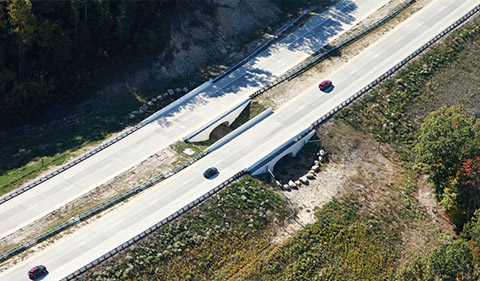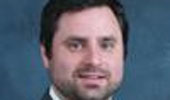Dr. Willem Roosenburg, Professor of Biological Sciences, is part of an Ohio University team awarded a three-year, $600,000 federally funded research contract form the Ohio Department of Transportation (ODOT) to monitor traffic safety and the effectiveness of wildlife preservation efforts along the new U.S. Route 33 Nelsonville Bypass.
The 8.5-mile, $200 million project, which opened in October 2013, relieved a major congestion problem on U.S. 33 by constructing a new four-lane bypass around the city of Nelsonville. With nearly five miles of the highway bisecting Wayne National Forest (WNF) — Ohio’s only national forest — ODOT invested $10 million to safeguard the forest’s natural habitat and threatened species with wildlife crossings and fencing, special high mast lighting, and the construction of a 7.5 acre wetland.
According to transportation engineer Deb McAvoy, chair of the Department of Civil Engineering in the Russ College of Engineering and Technology and principal investigator for the contract, such solutions are more typically found only in the western United States for large mammal preservation.
“This project is the first of its kind in Ohio,” McAvoy said of the cutting-edge wildlife and environmental mitigation techniques that include wildlife jump-outs for deer, a meadow habitat bridge, and animal culverts for amphibians, reptiles, mammals and other wildlife to use for safe crossing.
“We are excited about this study as it will provide, for the first time, real data on the effectiveness of the mitigation techniques we used,” said ODOT District 10 Deputy Director T. Steve Williams.
Working closely with ODOT ecologists, engineers, and Wayne National Forest ecologists, McAvoy and other Russ College faculty, staff and students; along with teams from the Voinovich School of Leadership and Public Affairs; College of Arts & Sciences; and private industry will evaluate the initiatives’ effectiveness.
The high-mast lighting encourages bats hunting for insects to circulate safely 100 feet above traffic. Eight-foot high fences deter deer from jumping onto the roadway, while deer jump-outs enable deer to exit the roadway and prevents them from returning to the traveled roadway.
McAvoy’s team will study traffic flow, road-kill rates and the effectiveness of the deer jump-outs. “The key is to reduce deer crashes in order to maintain traffic flow along the roadway while reducing the impact to individual motorists associated with such crashes.”
Scott Miller, director of energy and environmental programs at the Voinovich School, said Voinovich School field ecologists and GIS specialists will determine which pieces of the protective and mitigation efforts are working most effectively.
“A great mix of technological expertise and project specialists are coming together. The project is the glue that binds them,” he said. “I’m itching to get started, hoping to lay the foundation for the future. We’re starting on the ground floor for blending engineering and environmental habitat analysis.”
Meanwhile, biological sciences experts will be divided into teams according to specialty. Dr. Willem Roosenburg, professor of biological sciences, and his team will study amphibians and reptiles.
“Part of our job will be to evaluate the size of the population and impact of the bypass. Barriers are in place to prevent crossings, and there are fences to direct animals to the culverts,” he explained.
In addition to photographs, radio telemetry, which tags the animal with a radio transceiver, will also be used to help map where animals live and how they’re using the new structures. Once animal use is observed, professional and student researchers will identify the species and analyze how the animals are behaving.
“We’ll determine if the animal crossed the entire culvert, thereby maintaining use of its full habitat. Or did the animal refuse entry, essentially exiting the culvert on the same side as entry, thereby being restricted from its habitat?” McAvoy explained.
Robert Wiley, a senior field ecologist with the Voinovich School, said the project also could yield new findings about how animals adapt to construction like the highway development and resulting habitat fragmentation, for example, that bobcats or bear might use the deer pass, not just deer.
“The final results of the research will have a lasting impact on the future of environmental considerations for transportation projects,” Williams noted.




















Comments